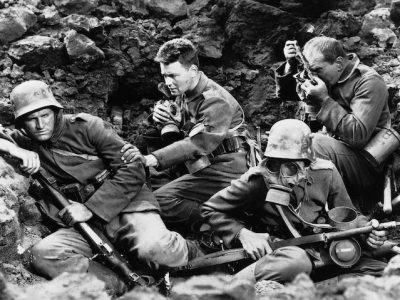The 1928 novel by former soldier Erich Maria Remarque is considered by many to be the greatest anti-war work of the 20th century, if not of all time. A product of Remarque’s experiences as a German Infantryman in WW I, this timeless story has twice been adapted into a motion picture by U.S. studios, first in 1930 and again in a 1979 made-for-TV movie.
The 1930 version, directed by Lewis Milestone and starring Lew Ayres, was nominated for five Academy Awards, winning Best Picture and Best Director. The later version, directed by Delbert Mann and starring Emmy and Golden Globe Award winner Richard Thomas and Academy Award winner Ernest Borgnine, was also a critical success, winning a Golden Globe for Best Motion Picture Made for Television and an Emmy for Outstanding Film Editing.
Each movie opens by telling us that “It will try simply to tell of a generation of men, who even though they may have escaped its shells, were destroyed by the war.” From there we follow idealistic schoolboy Paul Baumer and his classmates from their small German village into the German Army at the onset of WW I. We accompany them through training and finally into the horrendous slaughter of WW I’s trench warfare. They are assigned to a squad led by Stanislaus “Kat” Katczinsky. A grizzled veteran, “Kat” tries to teach the boys all they need to know to survive in combat. But it is not enough to save them from the physical and psychological ravages they are doomed to endure.
Although told from the German soldiers’ point of view, its universal condemnation of war made it an international success. In perhaps an unintended validation, both the book and movie were banned, and actually burned in 1930s Germany. They were deemed unpatriotic and not in keeping with the spirit of the Third Reich as the Nazi regime was preparing its people for war.
As a side note: Partially due to the aftereffect of making the movie, actor Lew Ayres declared himself a conscientious objector in WW II. This was at a time when Jimmy Stewart, Clark Gable and many of Hollywood’s biggest stars were volunteering for service. Thought to be a coward, Ayres was shunned in Hollywood, and MGM Studios dropped his contract. What was not known was that Ayres told his draft board, “I would like to be of service to my country in a constructive way and not a destructive way.” He volunteered for service overseas, serving as an Army medic and a chaplain’s assistant, earning three Battle Stars in the South Pacific. Although he did not carry a weapon, Ayres saw extensive combat, principally in the Battle of Leyte in the Philippines. True to his convictions, he donated 100 percent of his Army pay to The American Red Cross!
To view a trailer of the 1930 version and purchase the video, click here.
To view the 1979 version free in its entirety, click here.



0 comments on “All Quiet on the Western Front”